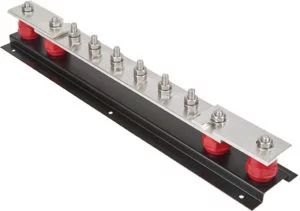Earth Bar Guide
Components of an Earth Bar
Understanding and designing Earth Bars should never be a difficult task.
Kingsmill are on hand to aid you with this design process to cater for any size, configuration or finish of Earth Bar. The sample Earth Bar, below, contains many elements that Kingsmill consider when designing special Earth Bars.

1: Outgoing Way
Outgoing ways enable the earth connection to be isolated from the test link.
This enables the test link to operate without the need to loosen the earth connection to the Earth Bar.
2: Standard Link
Standard test links are supplied on all Kingsmill Earth Bars unless outgoing ways are requested.
3: Parallel Fixings
Parallel fixings are typically used when there are space restrictions impacting on the installation of the Earth Bar.
By using parallel fixings, the length of an Earth Bar can be significantly reduced. Also, parallel fixings can be used to accommodate cable lugs with two fixing holes.
4: Staggered Fixings
Like parallel fixings, staggered fixings are typically utilised to lower the overall length of an Earth Bar in the event of space restrictions.
Parallel fixings can also be spaced to allow cable lug connections to be made from both sides of the Earth Bar.
5: No Fixings
Earth Bars can also be supplied without fixings. Options include punched holes, tapped holes or plain bar.
6: Fixings
Kingsmill Earth Bars are supplied with M10 brass fixings as standard.
We can also supply fixings of different size and material. These include M4 – M16 sizes and stainless steel, phosphor bronze and BZP materials.
7: Bases
Kingsmill supply all Earth Bars on metallic bases. All standard stock Earth Bars up to 12 ways (standard, single and twin link) are supplied on powder coated bases. Kingsmill can also supply galvanised and hot-dipped galvanised bases for use in external or more humid environments eg coastal.
Fixing Centres
Kingsmill Earth Bars are supplied as standard with a minimum 35mm distance between fixing centres. Typically, this allows for up to a 185mm² cable lug to be installed on adjacent fixings. Larger cable lugs may require larger fixing centre’s to accommodate wider cable lug palms.
High Quality Earth Bars
Manufacturing to Design Specifications
Standard Earth Bars meet the requirements of most applications.
However, we can design and manufacture an Earth Bar to suit special applications.
Send your specification to us and we will design a bespoke Earth Bar. This design is checked and confirmed by you before work commences.
Our standard Earth Bar Bases feature pre-drilled fixing holes for ease of installation and can be supplied powder-coated to reduce the risk of corrosion.
All Earth Bars are manufactured in our dedicated UK factory with a high level of quality control that ensures consistency.

Bespoke Specifications
All components in an Earth Bar can be specified, including:
- Size and material of bolt
- Nut and washer
- Length, width and thickness of bar
- Number of disconnecting links and their position
- The finish of the bar
. . . as well as many other variables.
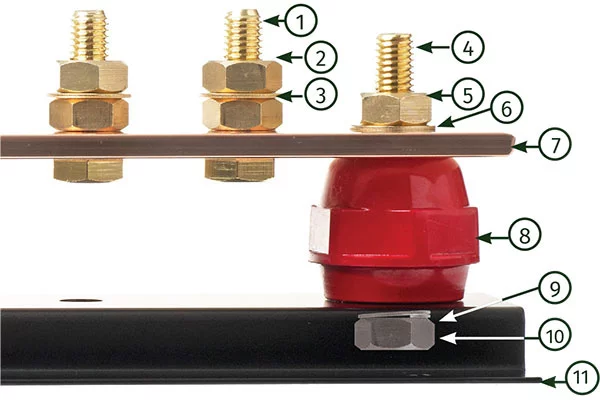
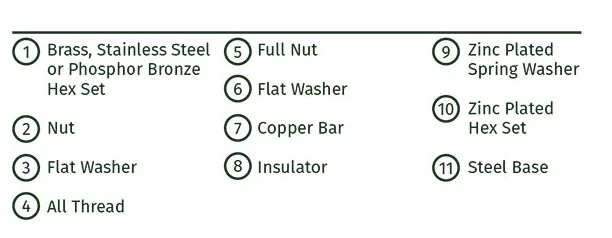
Standard or Tinned Earth Bar?
Standard Earth Bars are manufactured from bare copper bar. In most applications this does not cause any problems since the Earth Bars are located on the inside of a building, usually inside a dry, warm substation/communication room.
When this is not possible or practical, the Earth bar has to be located externally in a location that has higher moisture or humidity. In these cases, we recommend the use of a Tinned Earth Bar.
Tin
Tin is a soft white metal. It can easily be polished, scratch brushed or flow melted to give a bright finish. lt is non-toxic and it is not greatly affected by organic acids. Sulphur compounds do not readily tarnish tin. Neither is it impaired by air or water. Tin is one of the least susceptible metals to corrosion.
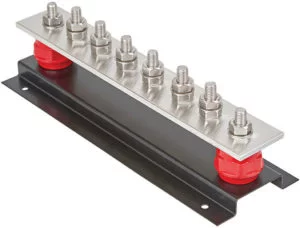
Benefits of a Tinned Earth Bar
Tinning a copper bar protects against atmospheric corrosion and hence provides a longer life when exposed to corrosive atmospheres.
A layer of tin protects the copper in the Earth Bar from the formation of copper oxide, thus preventing oxidation.
Tinned Earth Bars may be used in external applications or where atmospheric conditions are more severe and aggressive than normal ie high moisture content areas, high humidity etc.
A tinned Earth Bar resists corrosion from water.
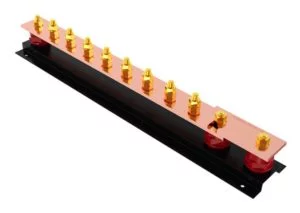
Key Features of a Tinned Earth Bar
- Manufactured from 50 x 6mm Tinned Hard Drawn Copper Bar
- M1O x 35 A2 Stainless Steel Connection Bolts
- Zero Halogen, Glass Reinforced Polyester Insulators c/w M10 brass Inserts
- Black powder coated steel base (hot dipped galvanised steel base can also be supplied)
- Pre-drilled base holes for ease of installation
